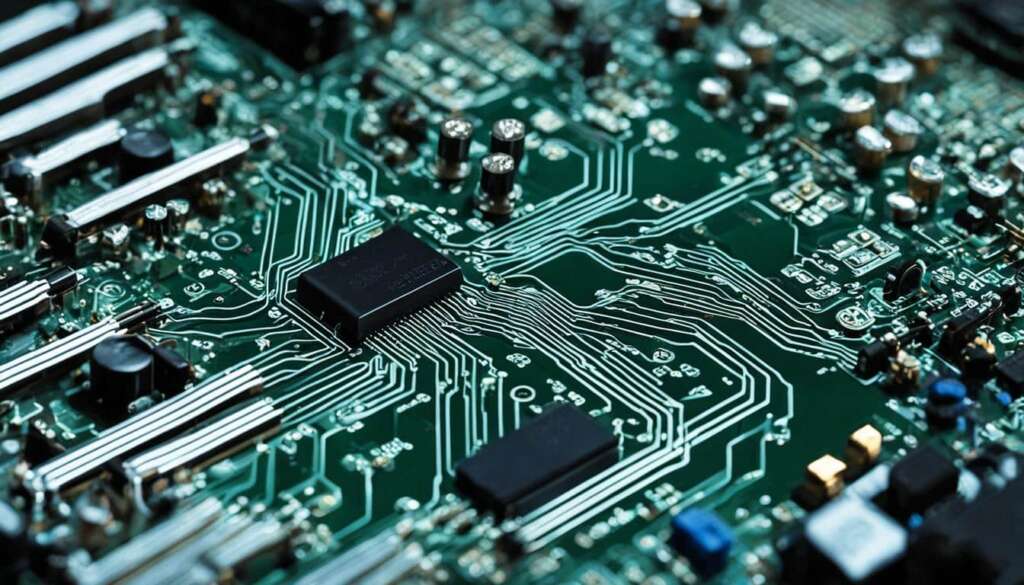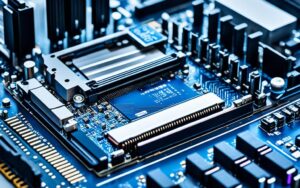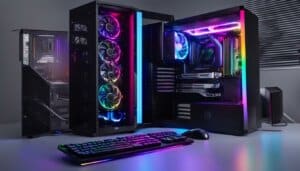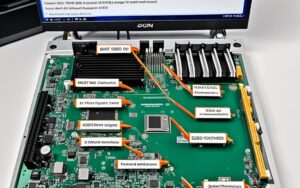Table of Contents
Computer hardware, with its tangible components, forms the foundation of any computing system. When we talk about computer hardware, we refer to the physical parts of a computer that can be seen and touched. These components play a crucial role in the overall functioning of a computer, working hand in hand with software to enable various tasks and operations.
Computer hardware can be classified into two main categories: internal and external components. Internal hardware components are the vital components that ensure the proper functioning of the computer system. They include the motherboard, CPU, RAM, hard drive, SSD, optical drive, heat sink, graphics processing unit, network interface card, and other important elements such as USB ports, power supplies, transistors, and chips.
On the other hand, external hardware components, also known as peripheral components, are connected to the computer to control input or output functions. These include devices like a mouse, keyboard, microphone, camera, touchpad, USB flash drive, memory card, monitor, printer, speaker, headphones, and earphones. These external components enhance usability and provide a seamless interaction between users and the computer system.
Hardware and software go hand in hand to ensure the smooth operation of a computer. While hardware represents the tangible components of a computer, software refers to the programs or instructions that tell the hardware what to do. Both components are interdependent and essential for the overall functioning of a computer system.
It’s also worth noting that advancements in technology have led to the emergence of hardware virtualization and hardware as a service. Hardware virtualization involves the creation of virtual versions of hardware components, providing more flexibility and efficiency in resource allocation. On the other hand, hardware as a service allows individuals or businesses to lease hardware from service providers, reducing the costs associated with owning and maintaining physical hardware.
In the upcoming sections of this article, we will delve deeper into the internal and external components of a computer, providing a comprehensive understanding of computer hardware and its essential role in everyday computing.
Internal Computer Hardware Components
Internal computer hardware components are crucial for the proper functioning of a computer system. These components work together to process instructions, store and retrieve data, and facilitate various operations. Understanding these internal hardware components is essential for anyone interested in computer technology.
The motherboard is a printed circuit board that acts as the central hub, connecting and allowing communication between various hardware components. It holds the CPU, RAM, and other essential components necessary for the computer’s operation.
The CPU, also known as the central processing unit, is often referred to as the “brain” of the computer. It is responsible for executing instructions, performing calculations, and managing the overall operation of the system.
RAM, or random access memory, is temporary storage that enables quick access to data by programs and the operating system. It plays a vital role in improving the computer’s performance and multitasking capabilities.
The hard drive, an electromechanical storage device, is used for permanent and temporary data storage. It stores the operating system, applications, files, and other data even after the computer is powered down.
SSDs, or solid-state drives, are another type of storage device that uses flash memory. They provide faster data access, higher reliability, and lower power consumption compared to traditional hard drives.
An optical drive allows the computer to read and interact with nonmagnetic external media, such as CDs and DVDs. It is commonly used for installing software, playing movies, or burning data onto optical discs.
A heat sink is a cooling device that draws heat away from components such as the CPU, GPU, and chipset. It helps regulate the temperature and prevent overheating, ensuring the computer’s stability and longevity.
The graphics processing unit (GPU) is responsible for rendering and displaying graphical data. It is particularly important for gaming, video editing, and other computationally intensive tasks that require fast and efficient graphics processing.
A network interface card (NIC) enables the computer to connect to a network. It allows for data transmission and communication between computers and other network devices, such as routers and switches.
In addition to these core components, internal hardware also includes features like USB ports for connecting peripherals, power supplies for supplying electricity, and various transistors and chips that support the overall functionality of the computer system.
Understanding the internal computer hardware components is fundamental for troubleshooting, upgrading, or building a computer system tailored to specific needs. It allows users to optimize performance, ensure compatibility, and make informed decisions when it comes to selecting and maintaining their hardware.
Note: The image above visually represents the interconnections and components of internal computer hardware.
External Hardware Components
External hardware components, also known as peripheral components, are essential for controlling input and output functions of a computer. These components enable us to interact with the computer system effectively.
Input hardware components include devices such as a mouse, keyboard, microphone, camera, touchpad, USB flash drive, and memory card. These devices provide instructions to the software and allow us to input data or interact through various mediums.
On the other hand, output hardware components include devices like a monitor, printer, speaker, headphones, and earphones. These devices render the results of executed programs and provide audio or visual output that enhances the overall user experience.
Both input and output hardware components play a crucial role in the functionality of the computer system, enabling seamless communication and facilitating effective data transfer between the user and the computer.
FAQ
What is computer hardware?
Computer hardware refers to the physical components of a computer system that can be seen and touched. It includes both internal and external components.
What are internal hardware components?
Internal hardware components are essential for the proper functioning of the computer and include the motherboard, CPU, RAM, hard drive, SSD, optical drive, heat sink, graphics processing unit, network interface card, and other components like USB ports, power supplies, transistors, and chips.
What is the role of the motherboard?
The motherboard is a printed circuit board that holds the CPU and other essential components.
What is the CPU?
The CPU is the brain of the computer that processes and executes instructions.
What is RAM?
RAM is temporary memory storage that makes information immediately accessible to programs.
What is the hard drive?
The hard drive is a physical storage device for permanent and temporary data.
What is an SSD?
SSDs are solid-state storage devices that can safely store data even when the computer is powered down.
What is an optical drive?
An optical drive allows the computer to read and interact with nonmagnetic external media.
What is the role of a heat sink?
A heat sink draws heat away from components to regulate their temperature.
What is the graphics processing unit (GPU)?
The graphics processing unit processes graphical data.
What is a network interface card?
A network interface card enables the computer to connect to a network.
What are external hardware components?
External hardware components, also known as peripheral components, are connected to the computer to control input or output functions.
What are input hardware components?
Input hardware components include devices like a mouse, keyboard, microphone, camera, touchpad, USB flash drive, and memory card.
What are output hardware components?
Output hardware components include devices like a monitor, printer, speaker, headphones, and earphones.
H3: What is the purpose of hardware virtualization?
Hardware virtualization is the creation of virtual versions of hardware components.
H3: What is hardware as a service?
Hardware as a service allows individuals or businesses to lease hardware from a service provider.








